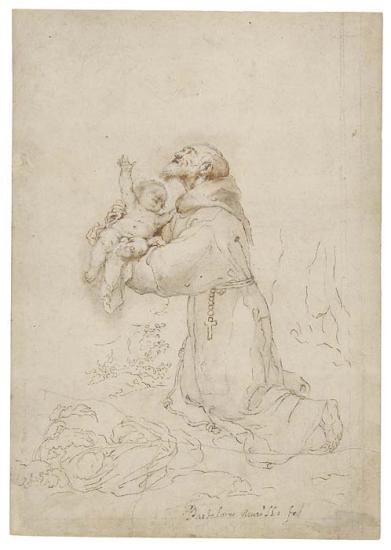
St. Felix of Cantalice Holding the Christ Child
Inscribed at lower right, Bartolome Murillo fet.
Purchased by Pierpont Morgan, 1909
ST. FELIX'S CHARITY REWARDED
Murillo was Seville's most successful artist during the seventeenth century. His largest commission was the pictorial decoration for the chapel of the Capuchinos de Sevilla. This drawing is a preparatory study for a painting of St. Felix of Cantalice, formerly on a side altar of that church. Felix was a member and patron of the Capuchins, an independent order of Franciscans; he was visited by the Virgin and Child as a reward for his charitable work. In this drawing, the artist explored the configuration of the kneeling saint and squirming Christ child, while the bread and setting are sparingly executed.
From the sixteenth to nineteenth centuries, Spain witnessed the rise of the Catholic Church along with the flourishing of court artists who explored deeply spiritual visions. Concurrently, the nightmare of the Inquisition drove artists to probe the darker side of human nature through scenes of martyrdom and torture. Drawing played a central role in their conception of these diverse subjects—from Murillo's preparatory studies for painting commissions to Goya's private albums satirizing contemporary society. In addition to this rich tradition in Spain, Spanish artists also worked abroad, notably in Naples, which was a Spanish territory.
Visions and Nightmares marks the first exhibition of Spanish drawings at the Morgan, whose holdings in this area are small but significant. Showcasing over twenty sheets by Spanish artists spanning four centuries, this selection traces the shifting roles and attitudes toward the art of drawing in Spain.
This online exhibition was created in conjunction with the exhibition Visions and Nightmares: Four Centuries of Spanish Drawings, on view January 17 through May 11, 2014 and organized by Edward Payne, Moore Curatorial Fellow.
This exhibition is made possible by the A. Woodner Fund.
